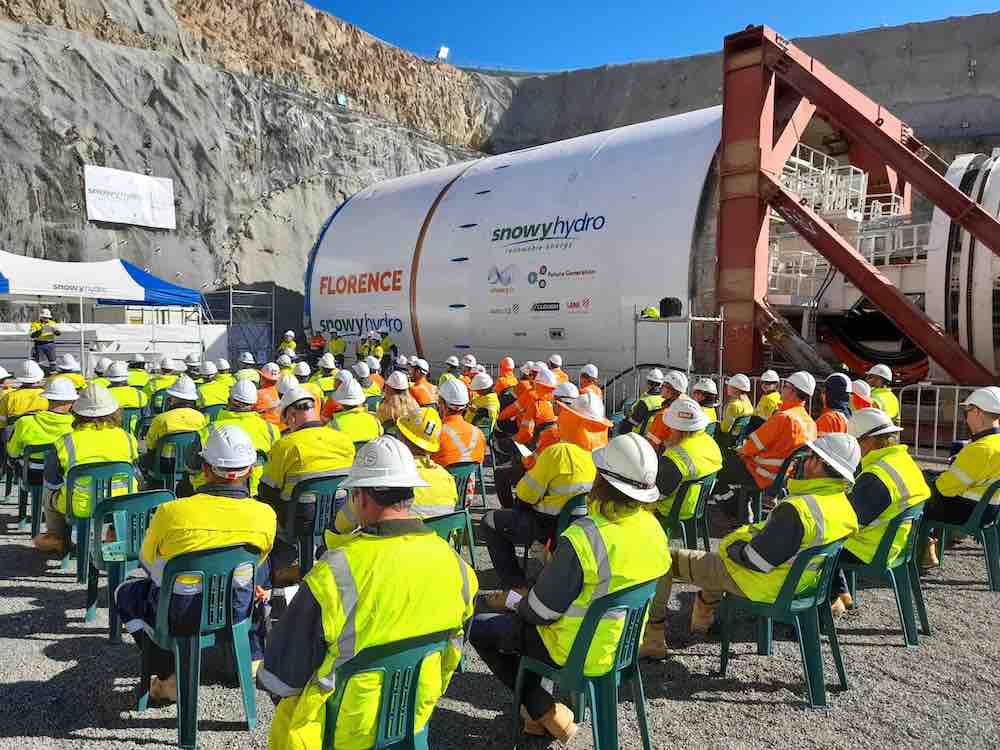Federal government-owned Snowy Hydro is facing new claims that its multi-billion dollar budget has blown out even further, as signs emerge of a ‘difference in interpretation’ of the contract between Snowy Hydro and the group hired to build the massive pumped hydro project.
A report published in The Australian on Monday claims a series of cost variation claims have been lodged with Snowy Hydro by Future Generation, a joint venture of Italy’s Webuild (formerly Salini Impregilo), Australian-based Clough and US-based Lane Construction.
According to the report, Snowy 2.0 is facing more than $2.2 billion of additional payment claims – extra costs that the engineering, procurement and construction teams have attributed to a mix of the Covid-19 pandemic and inflation.
RenewEconomy was unable to independently verify this claim, but in a report published in June by the Australian National Audit Office, a sample of 15 individual payment claims show a recurring and not insignificant gap between the amounts claimed by the contractors and the amounts paid by Snowy.

The total discrepancy between the amounts claimed and the money paid for this period alone adds up to roughly $1.7 billion, which – as the ANAO report notes – means Snowy Hydro’s actual amount paid was on average 57% lower than the amount claimed by the EPC contractor.
According to the ANAO report, however, Snowy Hydro has acted appropriately in this, by monitoring the EPC contractor’s performance and making payments consistent with the contract’s rules of credit.
The report says that on those occasions where payment claims were not fully met, it’s either because Snowy Hydro assessed that the EPC was not entitled to receive payment for the items claimed, or found that information presented in the claim sheets didn’t contain the latest performance data.
Ultimately, the ANAO report finds that Snowy’s contract management arrangements have provided an effective framework for managing the payment process with the contractor.
“The complexity of the project and the consistent reduction in payments made compared to amount claimed highlights the importance of Snowy Hydro Limited continuing to effectively implement the monthly payment claims assessment and approval process,” it says.
But in a letter provided to the auditor following a review of the report, the project director of Future Generation JV, Massimo Franceschi, says FGJV does not agree with this observation.
Franceschi says some of the underpayments documented in the report “relate to different evaluation of the works, variations and claims in which the parties had and/or have different positions in respect of FGJV’s entitlements under the EPC contract.”
And he stresses that “FGJV is concerned that the different interpretation of the contract will continue to generate difference in the actual payments compared with the amounts claimed.”
This apparent difference of contract interpretation, and the potential for it to result in further cost blowouts for Snowy 2.0, are just the latest bumps in the road for the controversial project, which in June was confirmed to be almost two years behind schedule.
The long-suspected revelation that the project is significantly delayed was delivered by the then new federal energy minister Chris Bowen, confirming fears it would not only cost more, but take longer than stated by both the previous Morrison government and Snowy Hydro.
It’s a massive project. Snowy 2.0 involves the construction of a new pumped hydro energy storage facility, through the digging of 27km of new underground tunnels that will be used to transfer water between the Tantangara and Talbingo dams.
A new 2,000MW power station will also be built between the two dams to provide up to 350,000 megawatt-hours of pumped hydro energy storage capacity.
When the Snowy 2.0 project was announced in 2017, by then prime minister Malcolm Turnbull, the estimated cost was just $2 billion. It was a figure widely viewed at the time to be undercooked.
The official cost estimate utlimately came in at $5.1 billion – which would cover the construction cost of the new tunnels and the power station – but would not include the cost of necessary transmission network upgrades, which will also run into the billions of dollars.
The total cost of construction and new network infrastructure is likely to exceed $10 billion.
As RenewEconomy has reported, the fact that Snowy 2.0 may now not begin delivering power until 2028 could have serious impacts on an energy market going through an unprecedented transition, and could have knock-on effects for other key decisions, such coal closure dates and market policy design.
For its part, Snowy Hydro told The Australian on Monday that it “rejects the reported claim” of a $2.2 billion blow-out in costs, and repeated its assertion made back in April, that the Future Generation joint venture has been significantly impacted Covid-19 and supply chain challenges.
A statement from FGJV reportedly said it was continuing to work closely with Snowy Hydro towards the successful delivery of this project.
Bruce Mountain, the director of the Victoria Energy Policy Centre, says the “dire financial position” of Snowy 2.0 is “not new news,” and that the chances of it coming in on budget, or within the terms of the contract, were “exactly zero.”
“We have long called for an independent inquiry into Snowy 2.0. The last government rejected this call. Our current government must heed it,” Mountain told RenewEconomy.
“This mess is not of their own making but if they do not act decisively to fix it up, including if necessary by putting a hold on further expenditure if warranted, then they too will be dragged into this train smash,” he said.
Ted Woodley, a former managing director of GasNet, PowerNet and EnergyAustralia, says it is worth pointing out that construction on Snowy 2.0 has only just begun.
“They haven’t even completed the 3km tunnel into the power station cavern, which was supposed to be done by mid-2021,” he said in comments shared with RenewEconomy.
“We should expect lots more problems and contingencies to come.”










